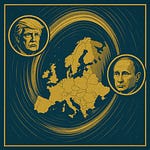Good morning, Europe! 🇪🇺 The world of global trade is more turbulent than ever, with shifting alliances, economic pressures, and an increasing focus on sustainability. But where does the European Union stand in this evolving landscape?
In this deep dive, we’ll explore the EU’s trade performance, its key partners, the strategy behind de-risking rather than decoupling, and how Europe is positioning itself as a leader in innovation and ethical trade.
The EU’s Surprising Trade Surplus 📊
Despite recent economic turmoil—think inflation, energy crises, and ongoing geopolitical tensions—the EU’s trade position has defied expectations. In 2024, the bloc posted a trade surplus of €150.1 billion, a massive turnaround from the trade deficits seen in 2022 and 2023.
So, what’s behind this recovery?
🔹 Strength in key industries: The EU’s machinery and vehicle sector alone recorded a €18.8 billion surplus in December 2024. European engineering and manufacturing continue to be highly competitive on the global stage.
🔹 Resilience in trade relationships: Despite challenges, Europe has maintained strong ties with its biggest partners while diversifying its export markets.
But trade numbers alone don’t tell the full story. Let’s look at the bigger picture: Who are Europe’s biggest trading partners, and what challenges lie ahead?
The EU’s Key Trade Partners: Friends, Frictions, and Future Opportunities 🌐
Trade is about relationships—some smooth, some complicated, and some outright tense. Let’s break down the EU’s biggest trade partners:
🇺🇸 United States – A Strong but Complex Ally
The US remains Europe’s largest export market, but unresolved trade tensions persist.
⚠️ The Inflation Reduction Act continues to cause concern for European businesses, as it incentivizes production in the US.
⚠️ Tariffs from the Trump era still linger, creating friction in key industries.
✅ However, cooperation in green technology and defense remains a strong point of collaboration.
🇬🇧 United Kingdom – A Delicate Post-Brexit Balance
Brexit led to a decline in trade, but both sides are looking for ways to normalize economic ties.
✅ The Windsor Framework has helped smooth supply chain issues in Northern Ireland.
⚠️ Regulatory divergence and trade bureaucracy still cause headaches for businesses.
🇮🇳 India – A Booming Market with Barriers
India’s expanding economy and massive consumer base make it an attractive partner. However, high tariffs and regulatory challenges still hinder EU access to this lucrative market.
🌍 Africa – A Resource-Rich but Unequal Relationship
Africa actually has a trade surplus with the EU, largely due to energy exports (oil & gas from Nigeria and Angola).
✅ The EU is investing in sustainable partnerships, but challenges around development and fair trade remain.
🇧🇷 Latin America – The Next Big Trade Deal?
The EU-Mercosur trade deal (if ratified) could create one of the world’s largest free trade areas. However, debates over environmental standards and deforestation continue to delay progress.
Clearly, the EU is working hard to diversify its trade relationships. But how is it balancing risks, particularly when it comes to China?
De-Risking, Not Decoupling: The EU’s Strategic Trade Approach 🏗️
There’s been a lot of talk about "decoupling" from China, but the EU is taking a more nuanced approach:
🔹 China is still the EU’s largest source of imports, making complete separation unrealistic.
🔹 Instead of decoupling, the EU is focusing on "de-risking", meaning diversifying supply chains and reducing dependency on a single country.
This means:
✅ Increasing domestic production of critical materials like semiconductors and batteries.
✅ Strengthening supply chain partnerships with countries like India, Vietnam, and Canada.
✅ Boosting European manufacturing capacity in key areas (e.g., the EU Chips Act).
This strategy isn’t just about reducing reliance on China—it’s about building a more resilient European economy.
What Gives the EU a Competitive Edge? 💡
The EU isn’t just about big trade deals—it also has unique strengths that set it apart in global markets:
🏭 "Made in Europe" Still Matters
European industries remain global leaders in:
✅ Automobiles (Germany)
✅ Aerospace (France)
✅ Luxury fashion (Italy)
These aren’t just products—they’re symbols of quality and craftsmanship.
🌿 Green Innovation Leader
Europe is a hotbed of green technology, leading in:
✅ Offshore wind energy (largest wind farm in the world 🌊)
✅ Battery technology for electric vehicles 🚗🔋
✅ Circular economy and sustainable production ♻️
📜 The "Brussels Effect" – Setting Global Standards
The EU’s strict regulations on privacy (GDPR), environmental standards, and product safety often become de facto global rules. Companies worldwide adjust to EU laws to access its massive market.
The Road Ahead: Challenges and Opportunities 🚀
While the EU has strengths, there are also big challenges ahead:
⚠️ Supply chain vulnerability: Still too reliant on China for raw materials.
⚠️ Internal market inefficiencies: Regulatory fragmentation slows business.
⚠️ Geopolitical uncertainty: US elections, trade wars, and regional conflicts could shake up trade flows.
But there’s also huge potential:
✅ Reshoring production: Bringing back manufacturing to Europe will strengthen economic resilience.
✅ Trade agreements: Deals with Latin America and Africa could open new markets.
✅ Technological leadership: Investments in semiconductors, biotech, and AI will secure Europe’s future.
Conclusion: The Future of EU Trade is Being Written ✍️
The EU is at a crossroads. With its commitment to multilateralism, sustainability, and innovation, it has the tools to shape the future of global trade.
The next few years will be pivotal—balancing economic security with openness, values with pragmatism, and growth with sustainability.
📢 What do you think? Will the EU succeed in building a more resilient and strategic trade policy? Share your thoughts in the comments! 💬
🔜 Stay tuned for Wednesday’s deep dive!












